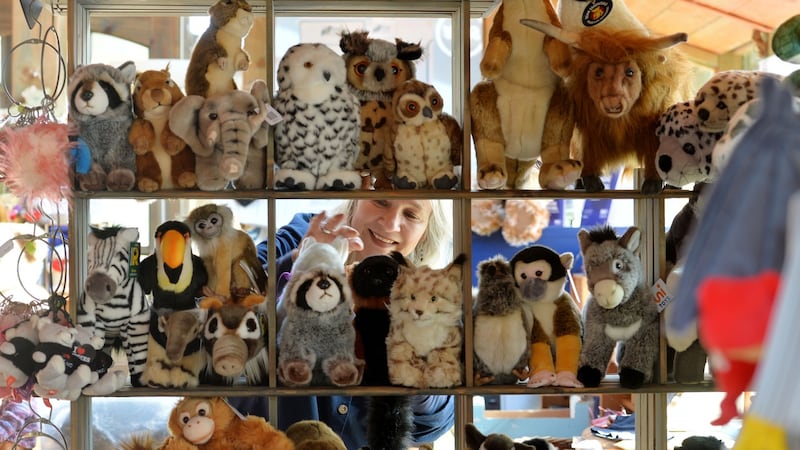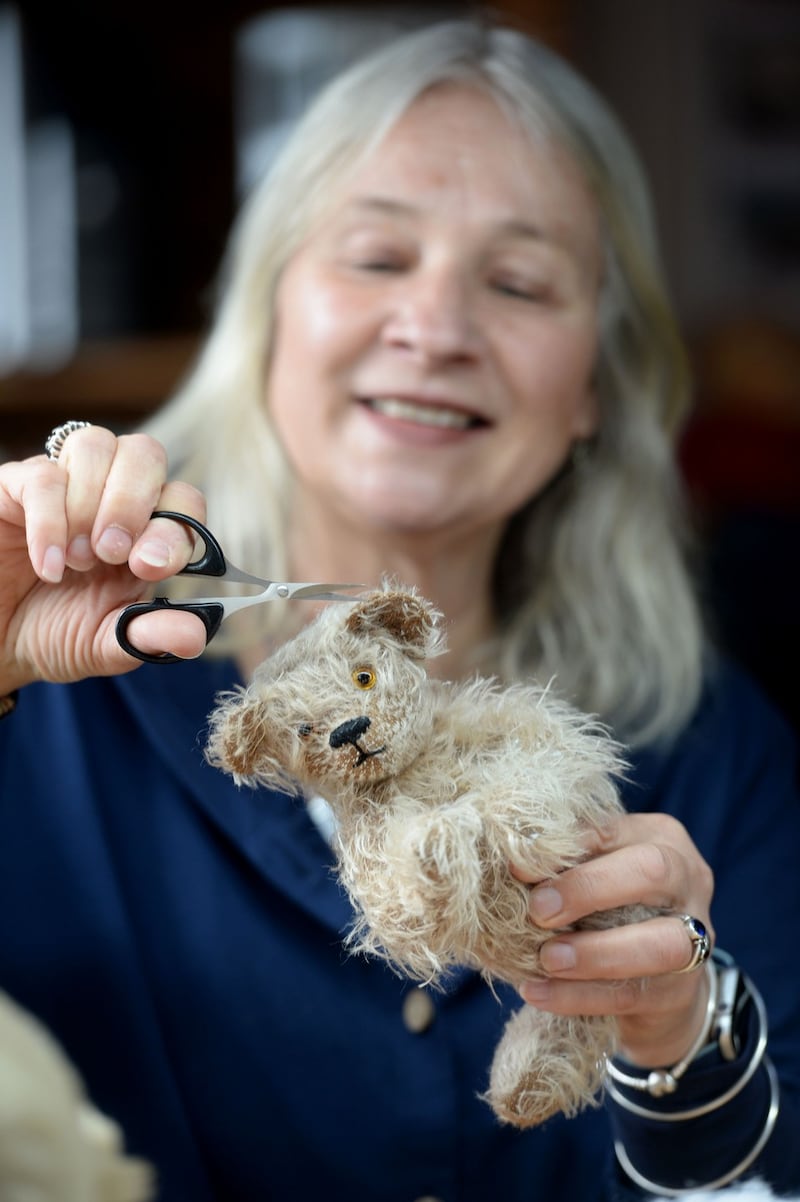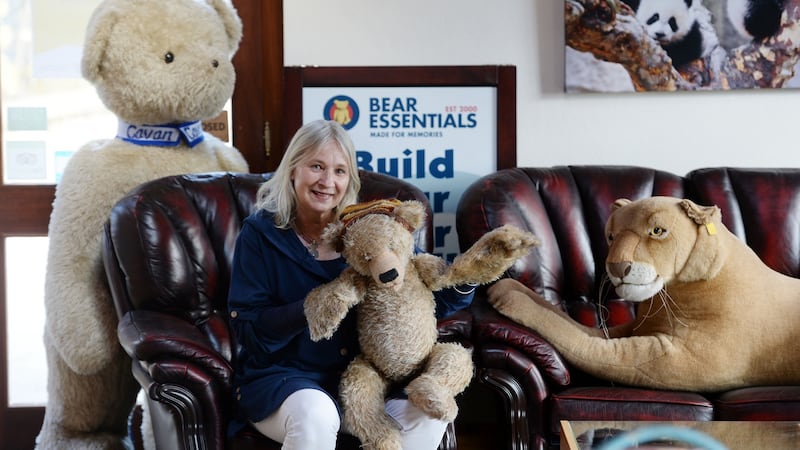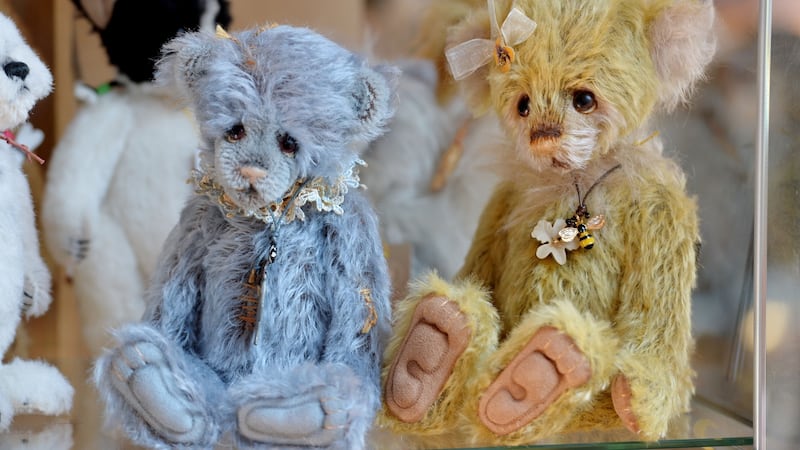Anyone who has had a favourite teddy bear will know that the value of the bear is not inherent in its original cost or in its resale value but in something less tangible yet more emotive.
A teddy might be a favourite because it protected you from the monsters under your bed or was the guest of honour at a picnic one halcyon summer’s day.
Tattered and torn, flat and forlorn, Anke Morgenroth, founder of the Bear Essentials shop and Teddy Bear Hospital in Co Cavan, has seen teddies in all states.
Morgenroth and her husband have lived in Ireland since 1984. Originally from Hamburg, Germany, they grew up in that strong tradition of Steiff teddy bears. Morgenroth originally trained as a social worker and used craft, art and design to communicate with children and their families, something that influenced her decision to make and sell teddy bears.

She designs a range of Irish teddies – soft ones for children and jointed collectible mohair teddy bears. The face is one of the most important aspects to get right. But more on this later.
Alongside her destination store, which stocks more than 1,000 teddies from brands such as Steiff, Keel, Bukowski and Jellycat, Morgenroth spends one day a week in her Teddy Bear Hospital repairing bears from around the world. Sadly not every bear can recover at the hospital.
“Sometimes I feel sad that I have to tell people that I can’t restore their bear,” says Morgenroth. “But if a bear is made with cotton materials, or has a lot of clothes that need restoring, we won’t repair them.”
If a bear’s face is totally gone, she won’t repair it either because, as readers will probably agree, a bear with a different face is not the same bear at all.
“A bear can be in really bad shape but as long as the face is intact, all the memories are there, or the memory of the person who gave the person the bear.”

I ask if it is not just the teddy bear that people want repaired but also the feelings attached to that bear. Morgenroth agrees that it is difficult to put a value on what a bear means to their owner. This is particularly poignant when a sibling has passed away.
Many customers are realistic about the repair process: “Recently we were sent a bear that meant a lot to the customer but the face had been ripped apart by a dog. We both agreed that it was better to leave some tiny pieces of the old mouth rather than make a new one. The customer was very happy with the outcome.”
Others have expectations beyond the capabilities of even the most expert teddy bear surgeon: “Some people think that you can bring the teddy back to its original glory,” she says. “If they give you a faded pink bear, they think that you can give them back a bright pink bear. If there is a leg, ear or arm missing, we might design a new one but if everything is missing, it would be too expensive and the customer might still feel it’s not their own bear,” she says.
Collecting bears
While many people collect bears, not all bears are “collectible”. “Usually ‘collectible’ means an item which is rare, has a resale value or was part of a limited edition,” Morgenroth explains. “It could be that the collector wants a bear of a certain colour or they’re missing a certain bear for their collection. Collectibility is usually connected to a company or artist or to a bear produced for a special occasion. The value of a teddy bear is based on the desirability of that bear at any one time.”
The monetary value of antique Steiff bears is dependent on their condition, provenance and the story attached to them. A Steiff bear from the turn of the 20th century can sell from about €500 but a rare white mohair Mr Edward Bear with tortoise-shell glasses (circa 1912) sold at Christie’s in London in 2006 for about €12,400. In 1994, a 1905 Steiff bear called Teddy Girl, who had been given to Colonel Bob Henderson when he was a baby, and later survived the D-Day landings with him, was sold after his death for 18 times the guide price, fetching £110,000 (€126,706) at auction.
One of the most striking characters Morgenroth has repaired was a large Steiff bear over a century old. “The owner was Irish but came from London with the bear. He had photos of the little girl who owned the bear when it was new. It was so wonderful.” If that little girl had been someone famous, the value of the bear would have been even greater.

Morgenroth has seen a rise in people seeking to have a bear repaired, or a memory bear made, following the death of a loved one from Covid-19. “People want me to repair or make a teddy bear to hold on to something that was part of their family history,” she says.
Not all enquiries are tinged with sadness though and Morgenroth recently repaired a bear for an 80th birthday present. “The woman’s husband had bought the teddy when the couple first met. The children secretly got it repaired. It meant a lot that the bear got a new lease of life. If a bear is made of mohair, in particular, and is repaired, it could last another 100 years.”
Being realistic
Many parents will know the unique feeling of terror felt when their child’s favourite bear is lost or begins to fall apart and Morgenroth gets many inquiries from panic-stricken parents. In these instances, she encourages parents to be realistic about the cost-effectiveness of having Snuggly, Poley or Cosy Doggy repaired.
“If you have a comforter that was bought five years ago for €20 and it needs a new arm or leg, the repair will likely cost more than the comforter. We often tell people to try to source a match and then we will use the leg or arm from the new one to mend the old one.”
In terms of cost, each patient is unique however, a new paw with new suede pads for a collectible teddy bear costs about €25. “If you have a valuable bear and you get the paws repaired, it can look almost like new so it would be worth it but if the bear has lots of other problems, that’s something we need to consider before repairing,” says Morgenroth.
Many people contact the Teddy Bear Hospital with cheap plush teddies that have nonetheless become much loved. Often these customers want to give it to a new baby but Morgenroth has some provisos.

“Many of these plush bears are made of cheap material and rather toxic stuffing, so we tell people that we will only repair the bear if the stuffing can be replaced. It’s important that people have all the information so they can make the decision that’s best for them and their bear.”
That said, it’s not always expensive bears that make the biggest impression.
“Sometimes we can get sweet little tiny bears and restoration can make them look really good again. We feel really happy sending them back to the customer knowing that the bear will have many more happy years with them or their child.”








